Investment Appraisal and Cash Management Analysis
VerifiedAdded on 2021/04/21
|17
|3534
|58
AI Summary
This assignment requires the application of various investment appraisal methods to evaluate two different options for a construction project. The analysis includes calculating Net Present Value (NPV), Internal Rate of Return (IRR), and payback period for each option. Additionally, it involves assessing the importance of effective cash management in business decision-making and its relationship with profitability. The assignment also requires referencing relevant literature and providing a conclusion based on the findings.
Contribute Materials
Your contribution can guide someone’s learning journey. Share your
documents today.

RUNNING HEAD: BUSINESS FINANCE
Cash management and capital budgeting
Cash management and capital budgeting
Secure Best Marks with AI Grader
Need help grading? Try our AI Grader for instant feedback on your assignments.
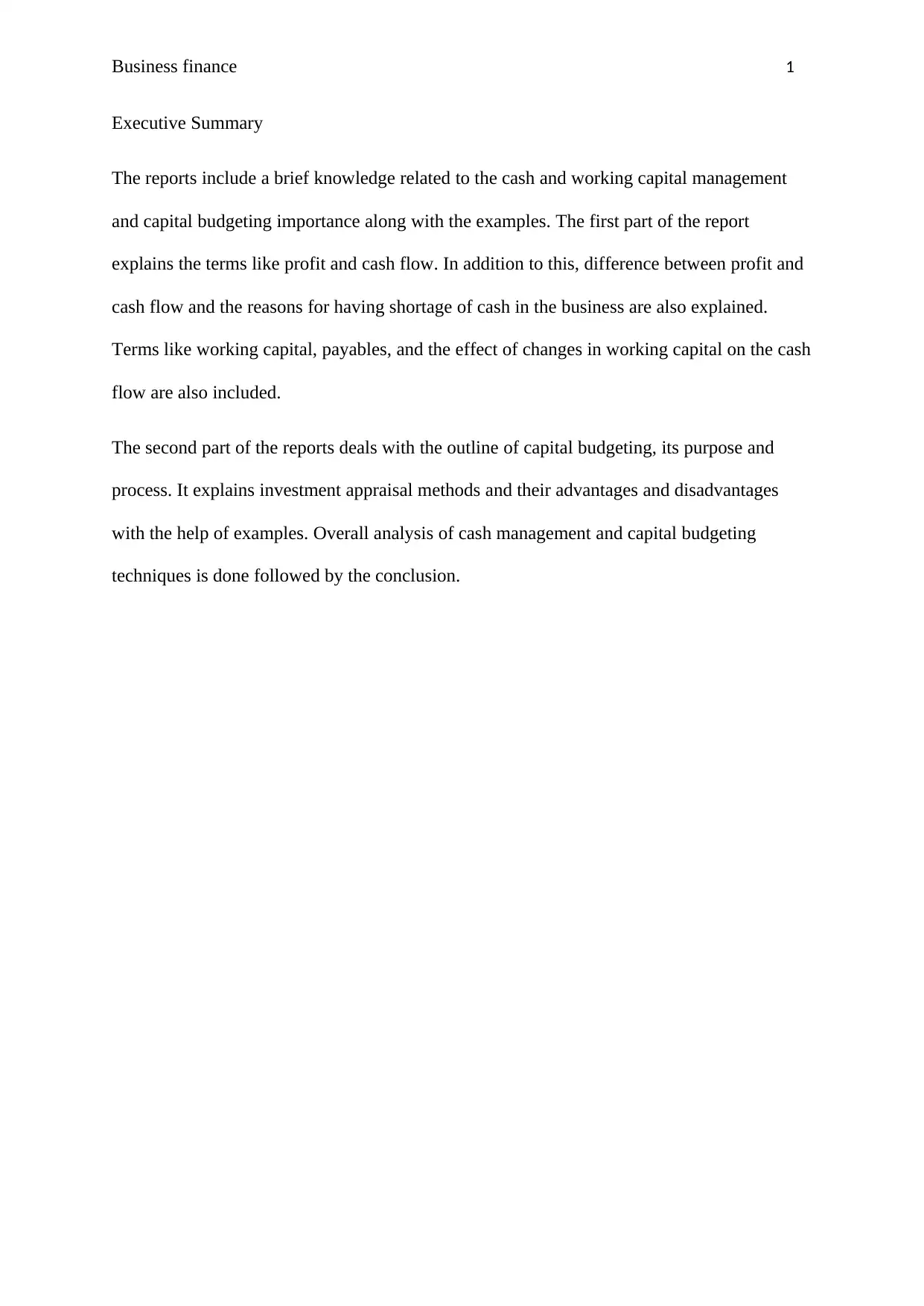
Business finance 1
Executive Summary
The reports include a brief knowledge related to the cash and working capital management
and capital budgeting importance along with the examples. The first part of the report
explains the terms like profit and cash flow. In addition to this, difference between profit and
cash flow and the reasons for having shortage of cash in the business are also explained.
Terms like working capital, payables, and the effect of changes in working capital on the cash
flow are also included.
The second part of the reports deals with the outline of capital budgeting, its purpose and
process. It explains investment appraisal methods and their advantages and disadvantages
with the help of examples. Overall analysis of cash management and capital budgeting
techniques is done followed by the conclusion.
Executive Summary
The reports include a brief knowledge related to the cash and working capital management
and capital budgeting importance along with the examples. The first part of the report
explains the terms like profit and cash flow. In addition to this, difference between profit and
cash flow and the reasons for having shortage of cash in the business are also explained.
Terms like working capital, payables, and the effect of changes in working capital on the cash
flow are also included.
The second part of the reports deals with the outline of capital budgeting, its purpose and
process. It explains investment appraisal methods and their advantages and disadvantages
with the help of examples. Overall analysis of cash management and capital budgeting
techniques is done followed by the conclusion.
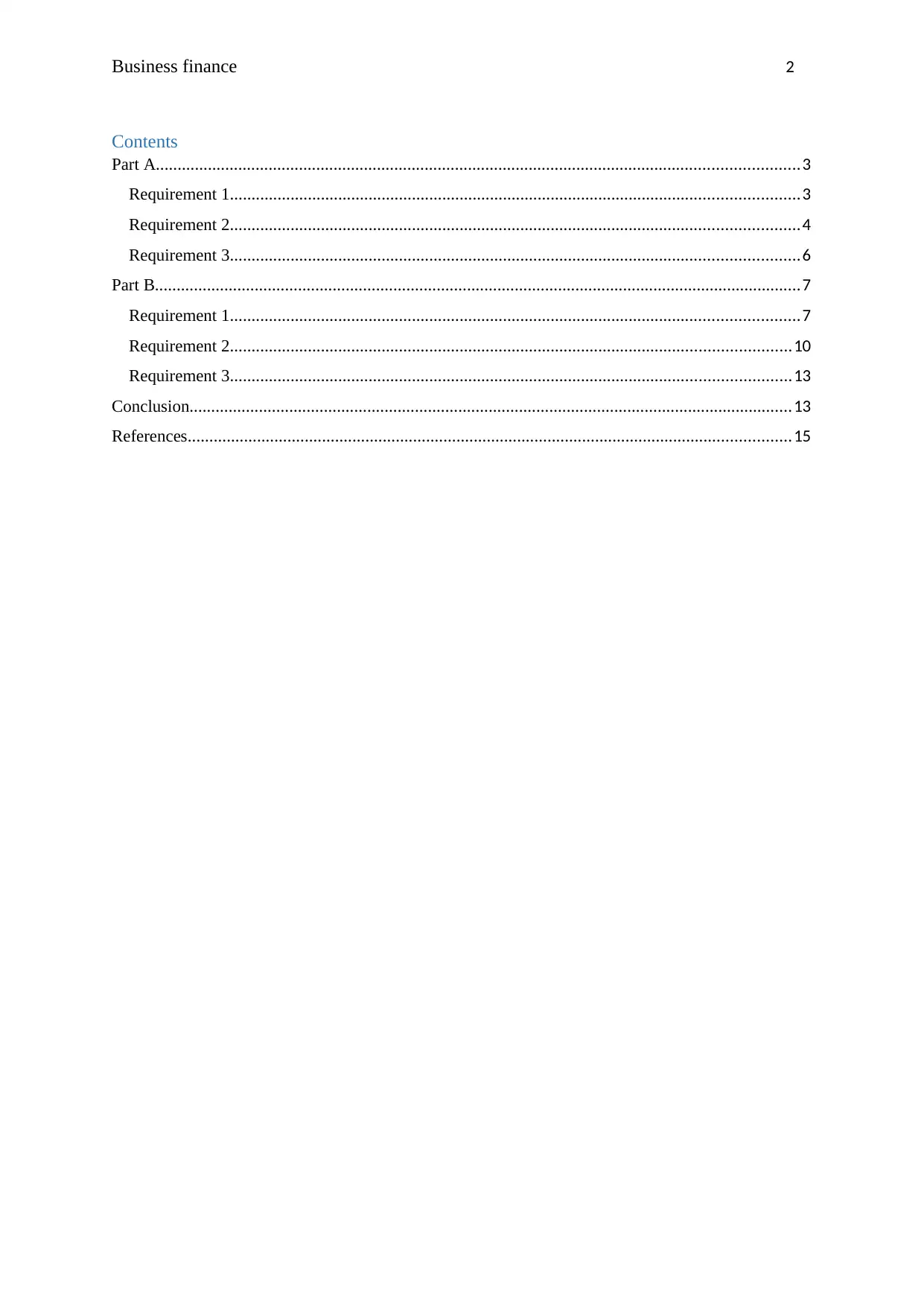
Business finance 2
Contents
Part A....................................................................................................................................................3
Requirement 1...................................................................................................................................3
Requirement 2...................................................................................................................................4
Requirement 3...................................................................................................................................6
Part B.....................................................................................................................................................7
Requirement 1...................................................................................................................................7
Requirement 2.................................................................................................................................10
Requirement 3.................................................................................................................................13
Conclusion...........................................................................................................................................13
References...........................................................................................................................................15
Contents
Part A....................................................................................................................................................3
Requirement 1...................................................................................................................................3
Requirement 2...................................................................................................................................4
Requirement 3...................................................................................................................................6
Part B.....................................................................................................................................................7
Requirement 1...................................................................................................................................7
Requirement 2.................................................................................................................................10
Requirement 3.................................................................................................................................13
Conclusion...........................................................................................................................................13
References...........................................................................................................................................15
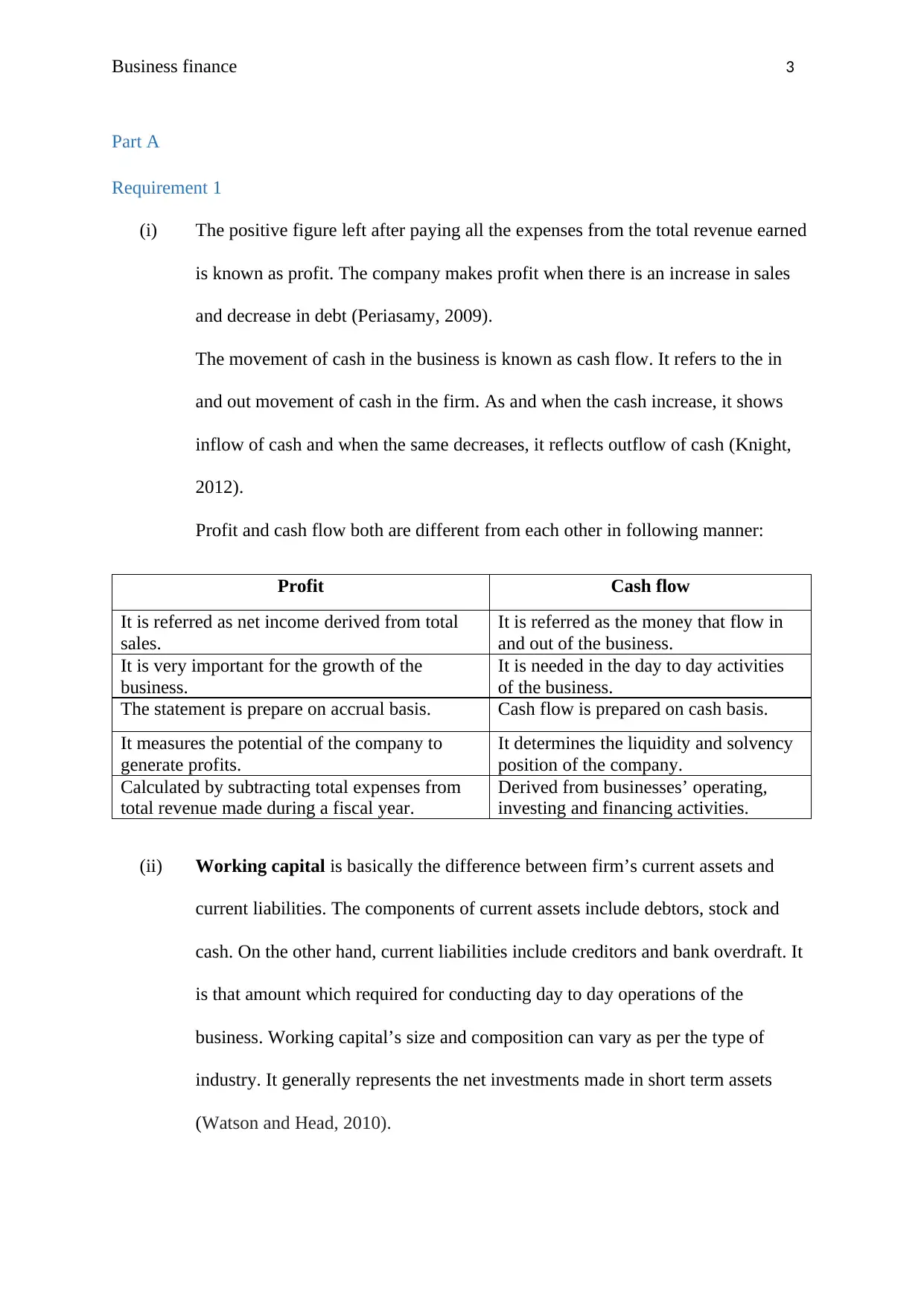
Business finance 3
Part A
Requirement 1
(i) The positive figure left after paying all the expenses from the total revenue earned
is known as profit. The company makes profit when there is an increase in sales
and decrease in debt (Periasamy, 2009).
The movement of cash in the business is known as cash flow. It refers to the in
and out movement of cash in the firm. As and when the cash increase, it shows
inflow of cash and when the same decreases, it reflects outflow of cash (Knight,
2012).
Profit and cash flow both are different from each other in following manner:
Profit Cash flow
It is referred as net income derived from total
sales.
It is referred as the money that flow in
and out of the business.
It is very important for the growth of the
business.
It is needed in the day to day activities
of the business.
The statement is prepare on accrual basis. Cash flow is prepared on cash basis.
It measures the potential of the company to
generate profits.
It determines the liquidity and solvency
position of the company.
Calculated by subtracting total expenses from
total revenue made during a fiscal year.
Derived from businesses’ operating,
investing and financing activities.
(ii) Working capital is basically the difference between firm’s current assets and
current liabilities. The components of current assets include debtors, stock and
cash. On the other hand, current liabilities include creditors and bank overdraft. It
is that amount which required for conducting day to day operations of the
business. Working capital’s size and composition can vary as per the type of
industry. It generally represents the net investments made in short term assets
(Watson and Head, 2010).
Part A
Requirement 1
(i) The positive figure left after paying all the expenses from the total revenue earned
is known as profit. The company makes profit when there is an increase in sales
and decrease in debt (Periasamy, 2009).
The movement of cash in the business is known as cash flow. It refers to the in
and out movement of cash in the firm. As and when the cash increase, it shows
inflow of cash and when the same decreases, it reflects outflow of cash (Knight,
2012).
Profit and cash flow both are different from each other in following manner:
Profit Cash flow
It is referred as net income derived from total
sales.
It is referred as the money that flow in
and out of the business.
It is very important for the growth of the
business.
It is needed in the day to day activities
of the business.
The statement is prepare on accrual basis. Cash flow is prepared on cash basis.
It measures the potential of the company to
generate profits.
It determines the liquidity and solvency
position of the company.
Calculated by subtracting total expenses from
total revenue made during a fiscal year.
Derived from businesses’ operating,
investing and financing activities.
(ii) Working capital is basically the difference between firm’s current assets and
current liabilities. The components of current assets include debtors, stock and
cash. On the other hand, current liabilities include creditors and bank overdraft. It
is that amount which required for conducting day to day operations of the
business. Working capital’s size and composition can vary as per the type of
industry. It generally represents the net investments made in short term assets
(Watson and Head, 2010).
Secure Best Marks with AI Grader
Need help grading? Try our AI Grader for instant feedback on your assignments.
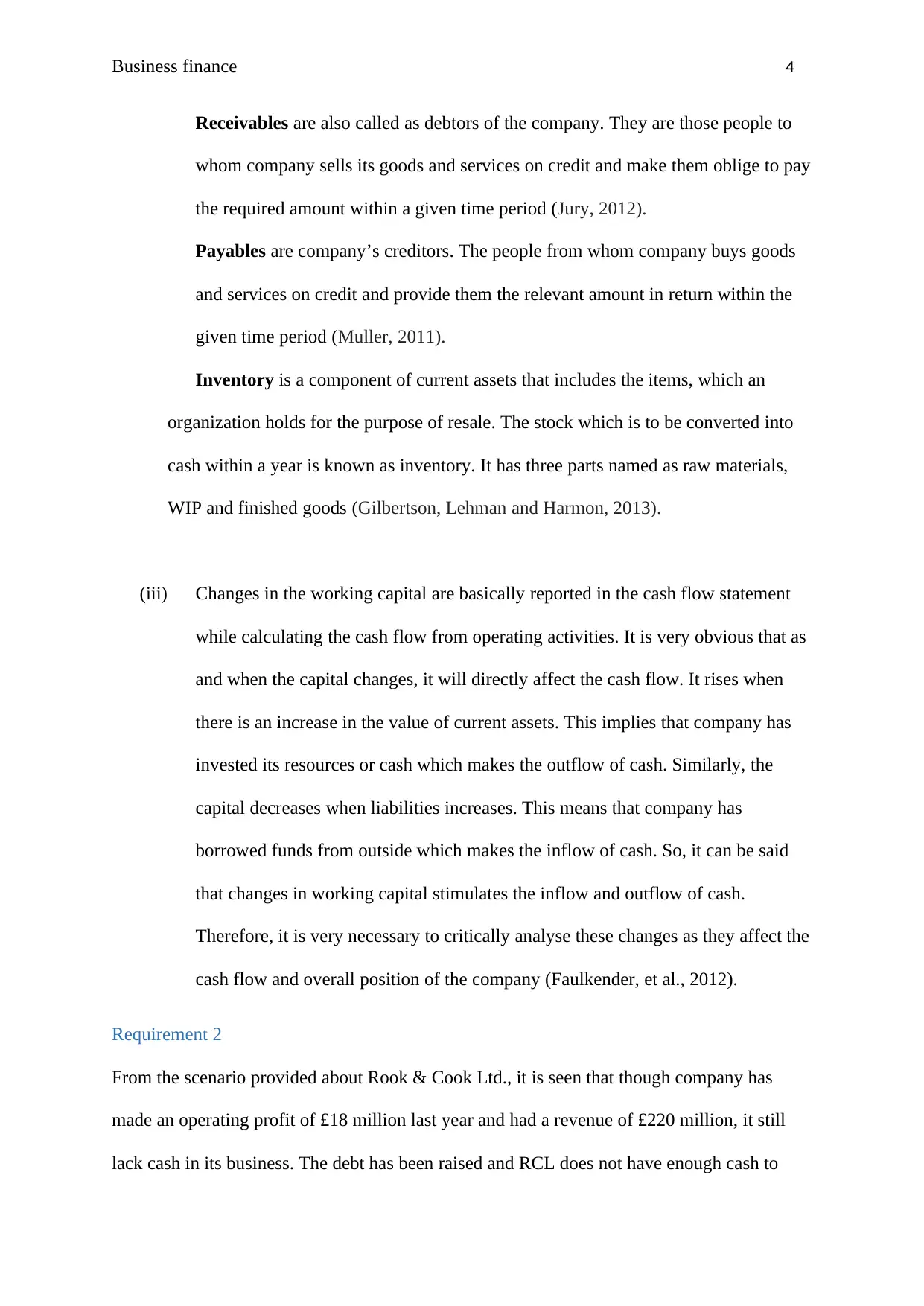
Business finance 4
Receivables are also called as debtors of the company. They are those people to
whom company sells its goods and services on credit and make them oblige to pay
the required amount within a given time period (Jury, 2012).
Payables are company’s creditors. The people from whom company buys goods
and services on credit and provide them the relevant amount in return within the
given time period (Muller, 2011).
Inventory is a component of current assets that includes the items, which an
organization holds for the purpose of resale. The stock which is to be converted into
cash within a year is known as inventory. It has three parts named as raw materials,
WIP and finished goods (Gilbertson, Lehman and Harmon, 2013).
(iii) Changes in the working capital are basically reported in the cash flow statement
while calculating the cash flow from operating activities. It is very obvious that as
and when the capital changes, it will directly affect the cash flow. It rises when
there is an increase in the value of current assets. This implies that company has
invested its resources or cash which makes the outflow of cash. Similarly, the
capital decreases when liabilities increases. This means that company has
borrowed funds from outside which makes the inflow of cash. So, it can be said
that changes in working capital stimulates the inflow and outflow of cash.
Therefore, it is very necessary to critically analyse these changes as they affect the
cash flow and overall position of the company (Faulkender, et al., 2012).
Requirement 2
From the scenario provided about Rook & Cook Ltd., it is seen that though company has
made an operating profit of £18 million last year and had a revenue of £220 million, it still
lack cash in its business. The debt has been raised and RCL does not have enough cash to
Receivables are also called as debtors of the company. They are those people to
whom company sells its goods and services on credit and make them oblige to pay
the required amount within a given time period (Jury, 2012).
Payables are company’s creditors. The people from whom company buys goods
and services on credit and provide them the relevant amount in return within the
given time period (Muller, 2011).
Inventory is a component of current assets that includes the items, which an
organization holds for the purpose of resale. The stock which is to be converted into
cash within a year is known as inventory. It has three parts named as raw materials,
WIP and finished goods (Gilbertson, Lehman and Harmon, 2013).
(iii) Changes in the working capital are basically reported in the cash flow statement
while calculating the cash flow from operating activities. It is very obvious that as
and when the capital changes, it will directly affect the cash flow. It rises when
there is an increase in the value of current assets. This implies that company has
invested its resources or cash which makes the outflow of cash. Similarly, the
capital decreases when liabilities increases. This means that company has
borrowed funds from outside which makes the inflow of cash. So, it can be said
that changes in working capital stimulates the inflow and outflow of cash.
Therefore, it is very necessary to critically analyse these changes as they affect the
cash flow and overall position of the company (Faulkender, et al., 2012).
Requirement 2
From the scenario provided about Rook & Cook Ltd., it is seen that though company has
made an operating profit of £18 million last year and had a revenue of £220 million, it still
lack cash in its business. The debt has been raised and RCL does not have enough cash to
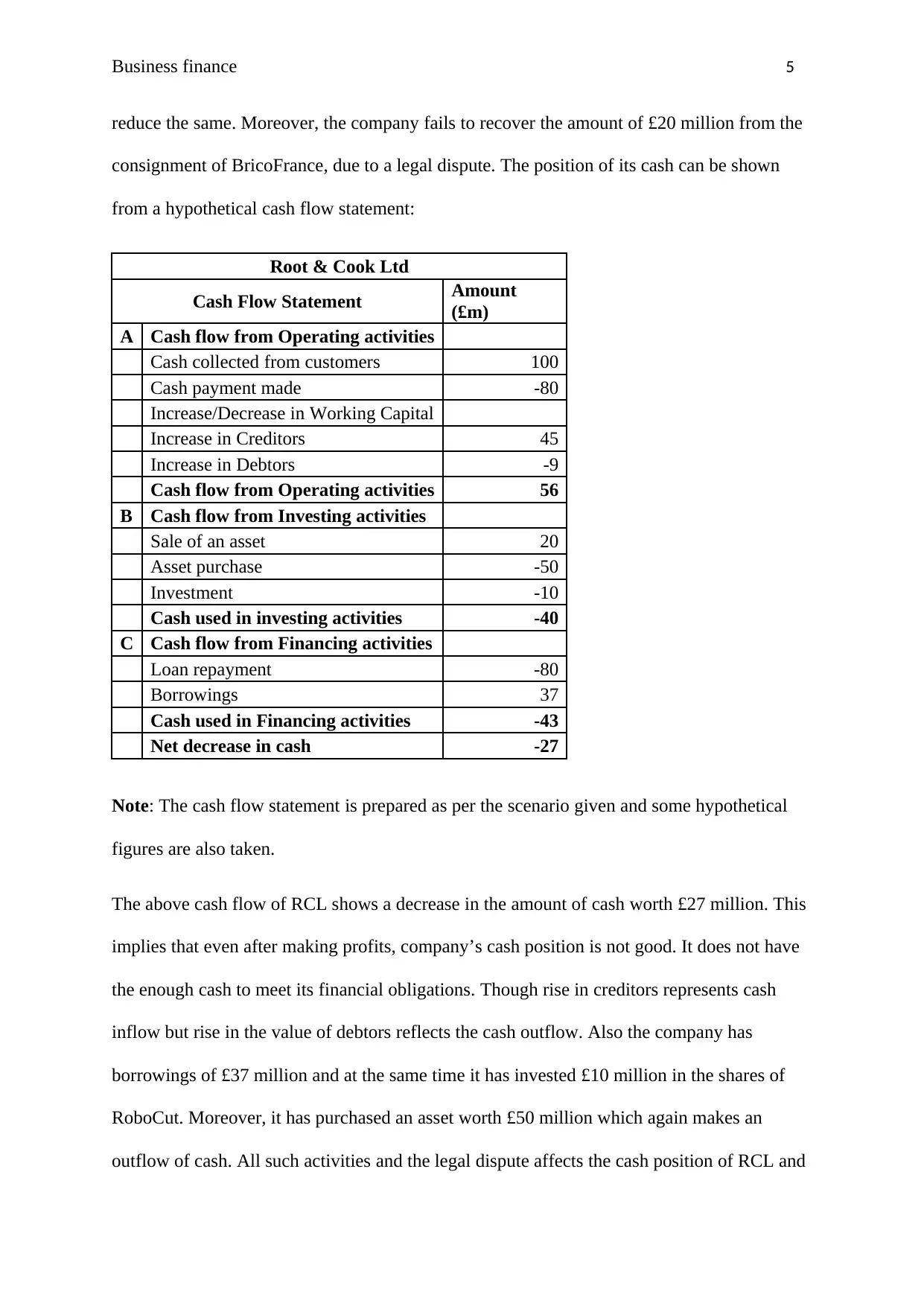
Business finance 5
reduce the same. Moreover, the company fails to recover the amount of £20 million from the
consignment of BricoFrance, due to a legal dispute. The position of its cash can be shown
from a hypothetical cash flow statement:
Root & Cook Ltd
Cash Flow Statement Amount
(£m)
A Cash flow from Operating activities
Cash collected from customers 100
Cash payment made -80
Increase/Decrease in Working Capital
Increase in Creditors 45
Increase in Debtors -9
Cash flow from Operating activities 56
B Cash flow from Investing activities
Sale of an asset 20
Asset purchase -50
Investment -10
Cash used in investing activities -40
C Cash flow from Financing activities
Loan repayment -80
Borrowings 37
Cash used in Financing activities -43
Net decrease in cash -27
Note: The cash flow statement is prepared as per the scenario given and some hypothetical
figures are also taken.
The above cash flow of RCL shows a decrease in the amount of cash worth £27 million. This
implies that even after making profits, company’s cash position is not good. It does not have
the enough cash to meet its financial obligations. Though rise in creditors represents cash
inflow but rise in the value of debtors reflects the cash outflow. Also the company has
borrowings of £37 million and at the same time it has invested £10 million in the shares of
RoboCut. Moreover, it has purchased an asset worth £50 million which again makes an
outflow of cash. All such activities and the legal dispute affects the cash position of RCL and
reduce the same. Moreover, the company fails to recover the amount of £20 million from the
consignment of BricoFrance, due to a legal dispute. The position of its cash can be shown
from a hypothetical cash flow statement:
Root & Cook Ltd
Cash Flow Statement Amount
(£m)
A Cash flow from Operating activities
Cash collected from customers 100
Cash payment made -80
Increase/Decrease in Working Capital
Increase in Creditors 45
Increase in Debtors -9
Cash flow from Operating activities 56
B Cash flow from Investing activities
Sale of an asset 20
Asset purchase -50
Investment -10
Cash used in investing activities -40
C Cash flow from Financing activities
Loan repayment -80
Borrowings 37
Cash used in Financing activities -43
Net decrease in cash -27
Note: The cash flow statement is prepared as per the scenario given and some hypothetical
figures are also taken.
The above cash flow of RCL shows a decrease in the amount of cash worth £27 million. This
implies that even after making profits, company’s cash position is not good. It does not have
the enough cash to meet its financial obligations. Though rise in creditors represents cash
inflow but rise in the value of debtors reflects the cash outflow. Also the company has
borrowings of £37 million and at the same time it has invested £10 million in the shares of
RoboCut. Moreover, it has purchased an asset worth £50 million which again makes an
outflow of cash. All such activities and the legal dispute affects the cash position of RCL and
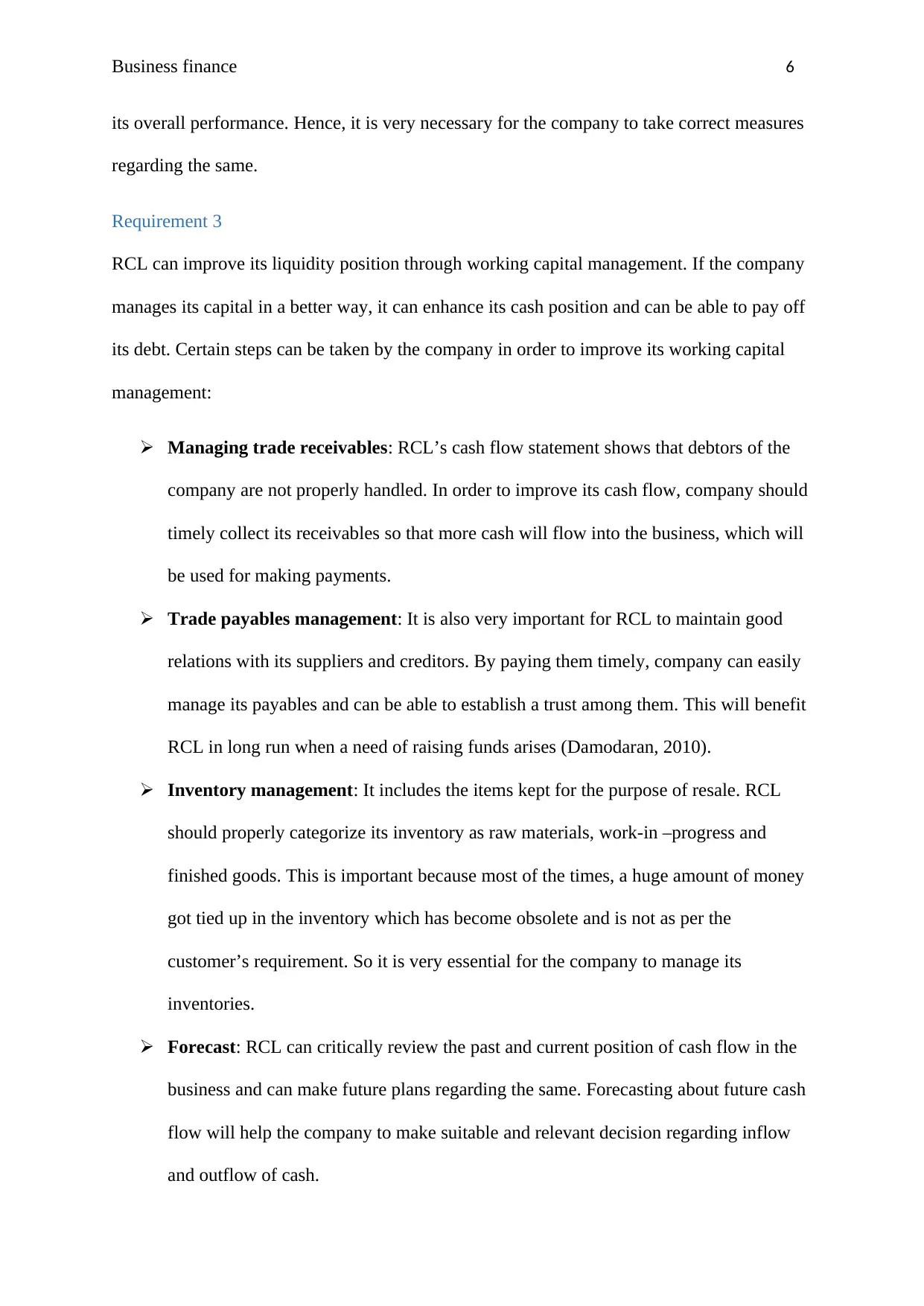
Business finance 6
its overall performance. Hence, it is very necessary for the company to take correct measures
regarding the same.
Requirement 3
RCL can improve its liquidity position through working capital management. If the company
manages its capital in a better way, it can enhance its cash position and can be able to pay off
its debt. Certain steps can be taken by the company in order to improve its working capital
management:
Managing trade receivables: RCL’s cash flow statement shows that debtors of the
company are not properly handled. In order to improve its cash flow, company should
timely collect its receivables so that more cash will flow into the business, which will
be used for making payments.
Trade payables management: It is also very important for RCL to maintain good
relations with its suppliers and creditors. By paying them timely, company can easily
manage its payables and can be able to establish a trust among them. This will benefit
RCL in long run when a need of raising funds arises (Damodaran, 2010).
Inventory management: It includes the items kept for the purpose of resale. RCL
should properly categorize its inventory as raw materials, work-in –progress and
finished goods. This is important because most of the times, a huge amount of money
got tied up in the inventory which has become obsolete and is not as per the
customer’s requirement. So it is very essential for the company to manage its
inventories.
Forecast: RCL can critically review the past and current position of cash flow in the
business and can make future plans regarding the same. Forecasting about future cash
flow will help the company to make suitable and relevant decision regarding inflow
and outflow of cash.
its overall performance. Hence, it is very necessary for the company to take correct measures
regarding the same.
Requirement 3
RCL can improve its liquidity position through working capital management. If the company
manages its capital in a better way, it can enhance its cash position and can be able to pay off
its debt. Certain steps can be taken by the company in order to improve its working capital
management:
Managing trade receivables: RCL’s cash flow statement shows that debtors of the
company are not properly handled. In order to improve its cash flow, company should
timely collect its receivables so that more cash will flow into the business, which will
be used for making payments.
Trade payables management: It is also very important for RCL to maintain good
relations with its suppliers and creditors. By paying them timely, company can easily
manage its payables and can be able to establish a trust among them. This will benefit
RCL in long run when a need of raising funds arises (Damodaran, 2010).
Inventory management: It includes the items kept for the purpose of resale. RCL
should properly categorize its inventory as raw materials, work-in –progress and
finished goods. This is important because most of the times, a huge amount of money
got tied up in the inventory which has become obsolete and is not as per the
customer’s requirement. So it is very essential for the company to manage its
inventories.
Forecast: RCL can critically review the past and current position of cash flow in the
business and can make future plans regarding the same. Forecasting about future cash
flow will help the company to make suitable and relevant decision regarding inflow
and outflow of cash.
Paraphrase This Document
Need a fresh take? Get an instant paraphrase of this document with our AI Paraphraser
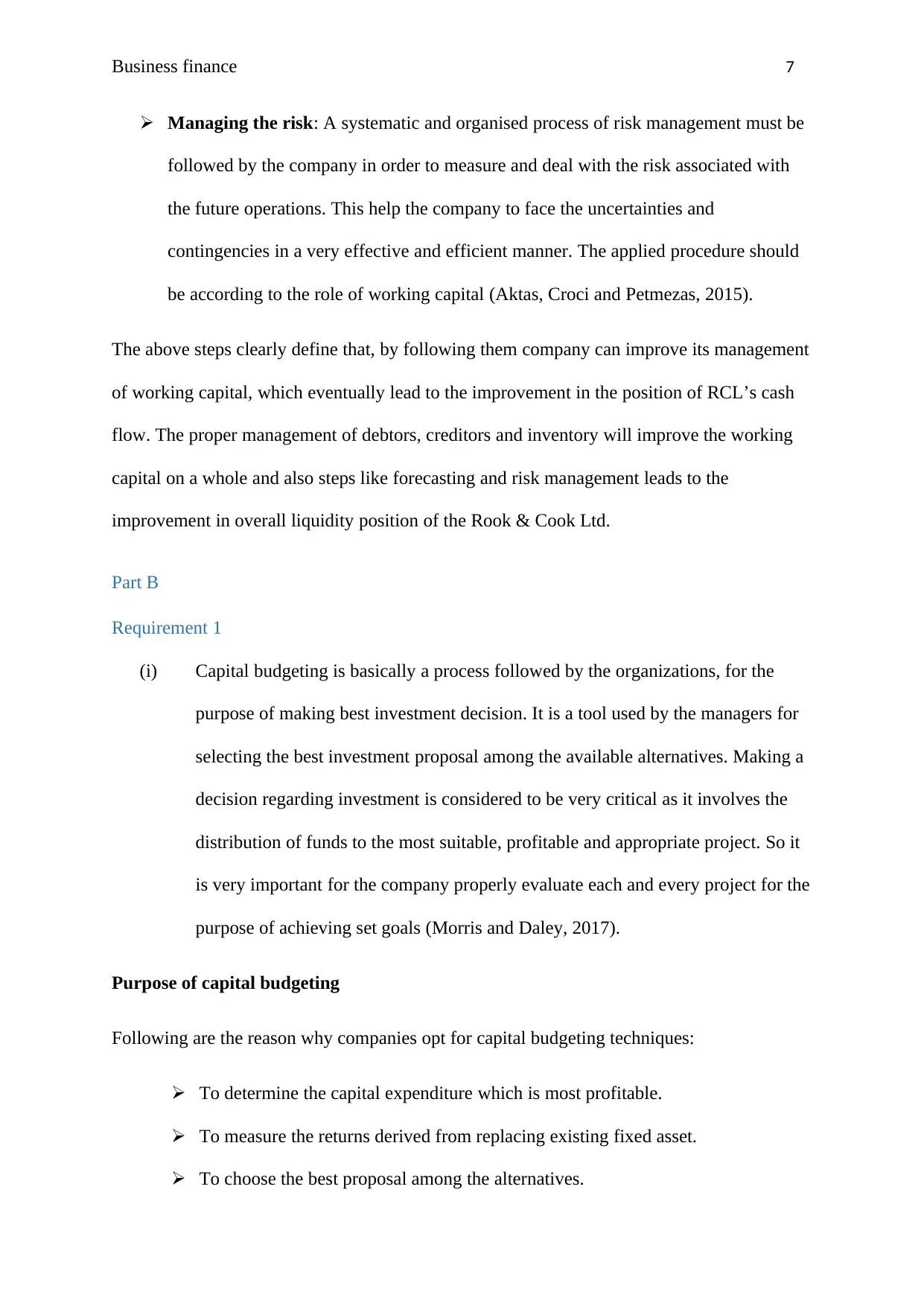
Business finance 7
Managing the risk: A systematic and organised process of risk management must be
followed by the company in order to measure and deal with the risk associated with
the future operations. This help the company to face the uncertainties and
contingencies in a very effective and efficient manner. The applied procedure should
be according to the role of working capital (Aktas, Croci and Petmezas, 2015).
The above steps clearly define that, by following them company can improve its management
of working capital, which eventually lead to the improvement in the position of RCL’s cash
flow. The proper management of debtors, creditors and inventory will improve the working
capital on a whole and also steps like forecasting and risk management leads to the
improvement in overall liquidity position of the Rook & Cook Ltd.
Part B
Requirement 1
(i) Capital budgeting is basically a process followed by the organizations, for the
purpose of making best investment decision. It is a tool used by the managers for
selecting the best investment proposal among the available alternatives. Making a
decision regarding investment is considered to be very critical as it involves the
distribution of funds to the most suitable, profitable and appropriate project. So it
is very important for the company properly evaluate each and every project for the
purpose of achieving set goals (Morris and Daley, 2017).
Purpose of capital budgeting
Following are the reason why companies opt for capital budgeting techniques:
To determine the capital expenditure which is most profitable.
To measure the returns derived from replacing existing fixed asset.
To choose the best proposal among the alternatives.
Managing the risk: A systematic and organised process of risk management must be
followed by the company in order to measure and deal with the risk associated with
the future operations. This help the company to face the uncertainties and
contingencies in a very effective and efficient manner. The applied procedure should
be according to the role of working capital (Aktas, Croci and Petmezas, 2015).
The above steps clearly define that, by following them company can improve its management
of working capital, which eventually lead to the improvement in the position of RCL’s cash
flow. The proper management of debtors, creditors and inventory will improve the working
capital on a whole and also steps like forecasting and risk management leads to the
improvement in overall liquidity position of the Rook & Cook Ltd.
Part B
Requirement 1
(i) Capital budgeting is basically a process followed by the organizations, for the
purpose of making best investment decision. It is a tool used by the managers for
selecting the best investment proposal among the available alternatives. Making a
decision regarding investment is considered to be very critical as it involves the
distribution of funds to the most suitable, profitable and appropriate project. So it
is very important for the company properly evaluate each and every project for the
purpose of achieving set goals (Morris and Daley, 2017).
Purpose of capital budgeting
Following are the reason why companies opt for capital budgeting techniques:
To determine the capital expenditure which is most profitable.
To measure the returns derived from replacing existing fixed asset.
To choose the best proposal among the alternatives.
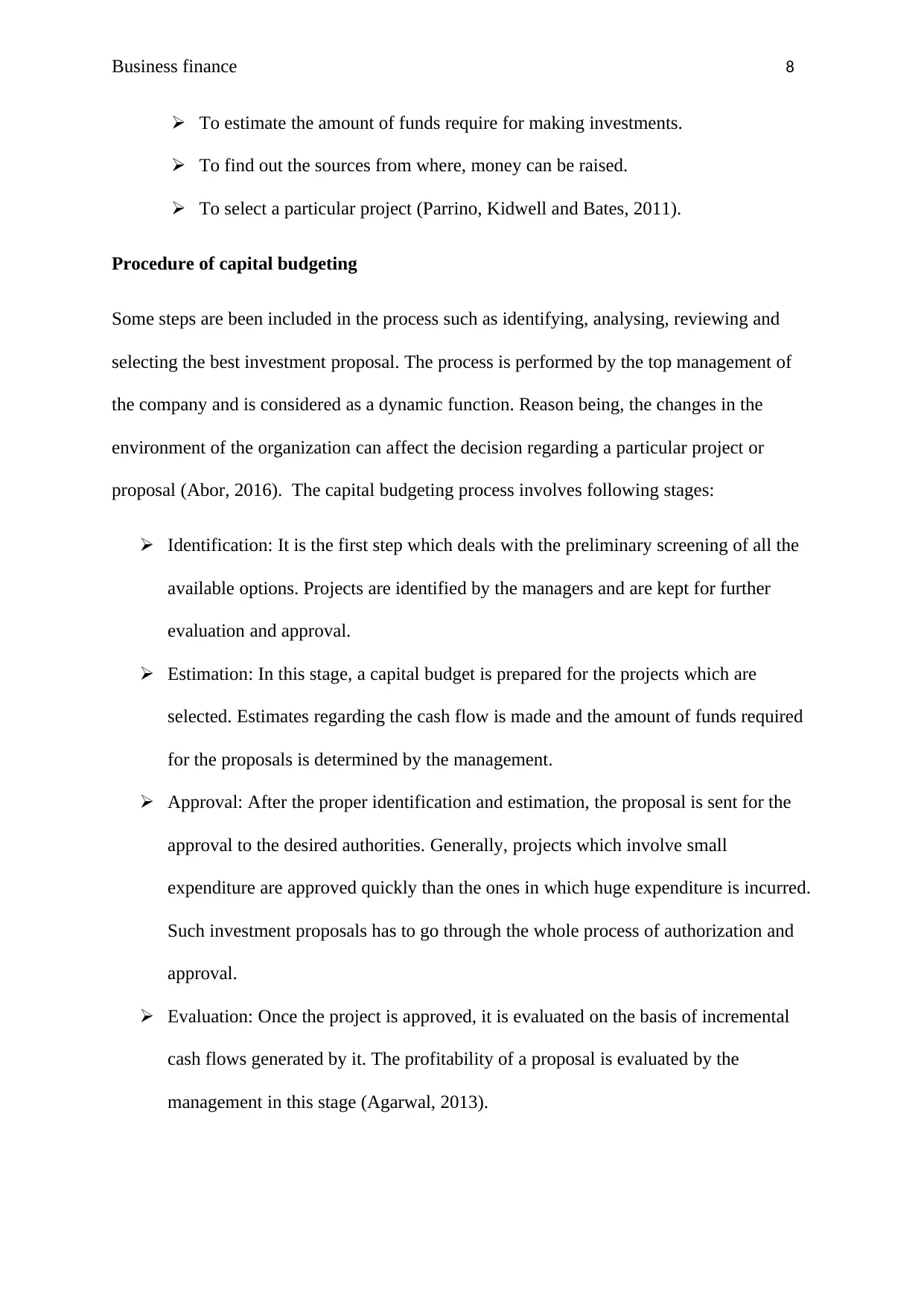
Business finance 8
To estimate the amount of funds require for making investments.
To find out the sources from where, money can be raised.
To select a particular project (Parrino, Kidwell and Bates, 2011).
Procedure of capital budgeting
Some steps are been included in the process such as identifying, analysing, reviewing and
selecting the best investment proposal. The process is performed by the top management of
the company and is considered as a dynamic function. Reason being, the changes in the
environment of the organization can affect the decision regarding a particular project or
proposal (Abor, 2016). The capital budgeting process involves following stages:
Identification: It is the first step which deals with the preliminary screening of all the
available options. Projects are identified by the managers and are kept for further
evaluation and approval.
Estimation: In this stage, a capital budget is prepared for the projects which are
selected. Estimates regarding the cash flow is made and the amount of funds required
for the proposals is determined by the management.
Approval: After the proper identification and estimation, the proposal is sent for the
approval to the desired authorities. Generally, projects which involve small
expenditure are approved quickly than the ones in which huge expenditure is incurred.
Such investment proposals has to go through the whole process of authorization and
approval.
Evaluation: Once the project is approved, it is evaluated on the basis of incremental
cash flows generated by it. The profitability of a proposal is evaluated by the
management in this stage (Agarwal, 2013).
To estimate the amount of funds require for making investments.
To find out the sources from where, money can be raised.
To select a particular project (Parrino, Kidwell and Bates, 2011).
Procedure of capital budgeting
Some steps are been included in the process such as identifying, analysing, reviewing and
selecting the best investment proposal. The process is performed by the top management of
the company and is considered as a dynamic function. Reason being, the changes in the
environment of the organization can affect the decision regarding a particular project or
proposal (Abor, 2016). The capital budgeting process involves following stages:
Identification: It is the first step which deals with the preliminary screening of all the
available options. Projects are identified by the managers and are kept for further
evaluation and approval.
Estimation: In this stage, a capital budget is prepared for the projects which are
selected. Estimates regarding the cash flow is made and the amount of funds required
for the proposals is determined by the management.
Approval: After the proper identification and estimation, the proposal is sent for the
approval to the desired authorities. Generally, projects which involve small
expenditure are approved quickly than the ones in which huge expenditure is incurred.
Such investment proposals has to go through the whole process of authorization and
approval.
Evaluation: Once the project is approved, it is evaluated on the basis of incremental
cash flows generated by it. The profitability of a proposal is evaluated by the
management in this stage (Agarwal, 2013).
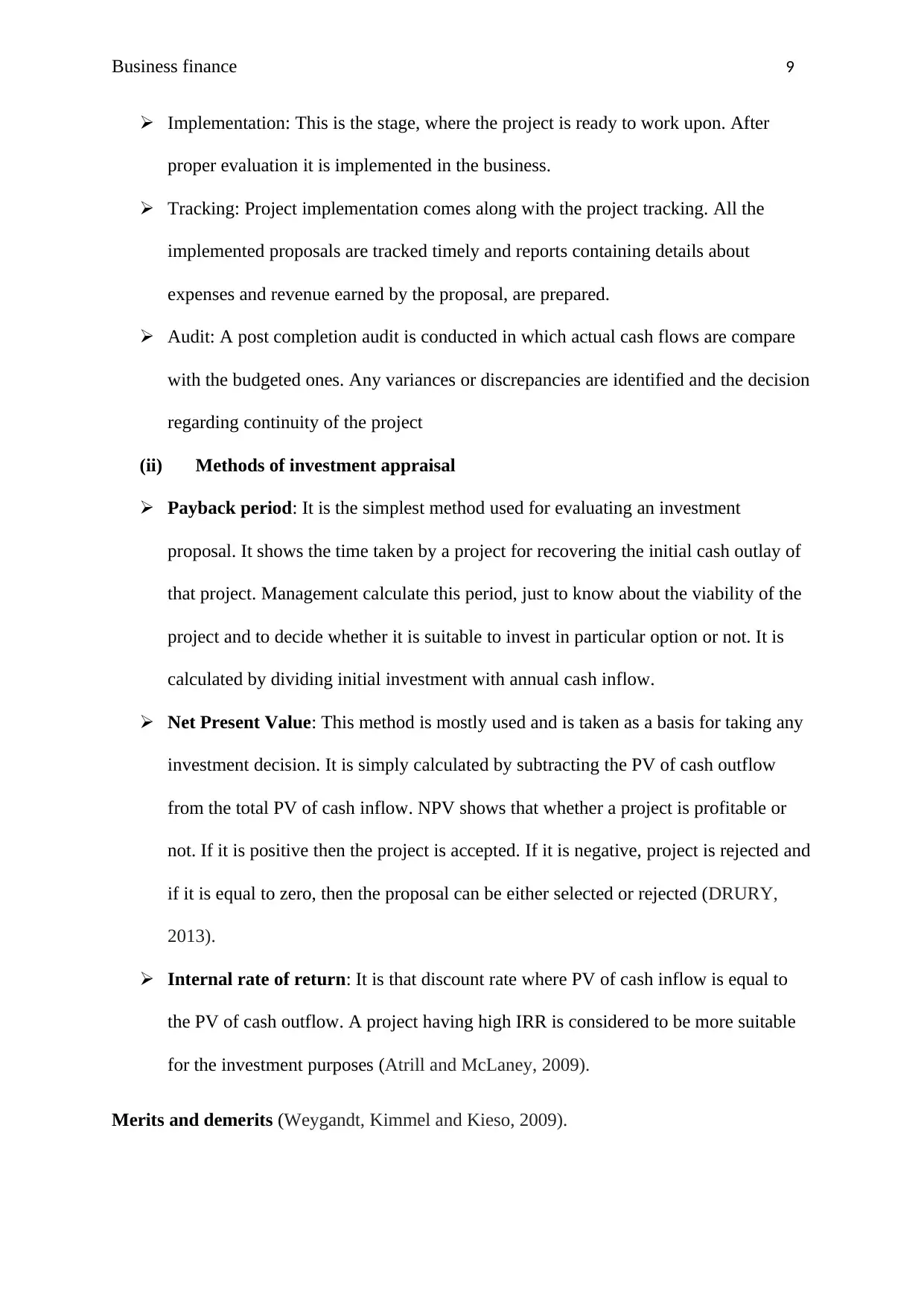
Business finance 9
Implementation: This is the stage, where the project is ready to work upon. After
proper evaluation it is implemented in the business.
Tracking: Project implementation comes along with the project tracking. All the
implemented proposals are tracked timely and reports containing details about
expenses and revenue earned by the proposal, are prepared.
Audit: A post completion audit is conducted in which actual cash flows are compare
with the budgeted ones. Any variances or discrepancies are identified and the decision
regarding continuity of the project
(ii) Methods of investment appraisal
Payback period: It is the simplest method used for evaluating an investment
proposal. It shows the time taken by a project for recovering the initial cash outlay of
that project. Management calculate this period, just to know about the viability of the
project and to decide whether it is suitable to invest in particular option or not. It is
calculated by dividing initial investment with annual cash inflow.
Net Present Value: This method is mostly used and is taken as a basis for taking any
investment decision. It is simply calculated by subtracting the PV of cash outflow
from the total PV of cash inflow. NPV shows that whether a project is profitable or
not. If it is positive then the project is accepted. If it is negative, project is rejected and
if it is equal to zero, then the proposal can be either selected or rejected (DRURY,
2013).
Internal rate of return: It is that discount rate where PV of cash inflow is equal to
the PV of cash outflow. A project having high IRR is considered to be more suitable
for the investment purposes (Atrill and McLaney, 2009).
Merits and demerits (Weygandt, Kimmel and Kieso, 2009).
Implementation: This is the stage, where the project is ready to work upon. After
proper evaluation it is implemented in the business.
Tracking: Project implementation comes along with the project tracking. All the
implemented proposals are tracked timely and reports containing details about
expenses and revenue earned by the proposal, are prepared.
Audit: A post completion audit is conducted in which actual cash flows are compare
with the budgeted ones. Any variances or discrepancies are identified and the decision
regarding continuity of the project
(ii) Methods of investment appraisal
Payback period: It is the simplest method used for evaluating an investment
proposal. It shows the time taken by a project for recovering the initial cash outlay of
that project. Management calculate this period, just to know about the viability of the
project and to decide whether it is suitable to invest in particular option or not. It is
calculated by dividing initial investment with annual cash inflow.
Net Present Value: This method is mostly used and is taken as a basis for taking any
investment decision. It is simply calculated by subtracting the PV of cash outflow
from the total PV of cash inflow. NPV shows that whether a project is profitable or
not. If it is positive then the project is accepted. If it is negative, project is rejected and
if it is equal to zero, then the proposal can be either selected or rejected (DRURY,
2013).
Internal rate of return: It is that discount rate where PV of cash inflow is equal to
the PV of cash outflow. A project having high IRR is considered to be more suitable
for the investment purposes (Atrill and McLaney, 2009).
Merits and demerits (Weygandt, Kimmel and Kieso, 2009).
Secure Best Marks with AI Grader
Need help grading? Try our AI Grader for instant feedback on your assignments.
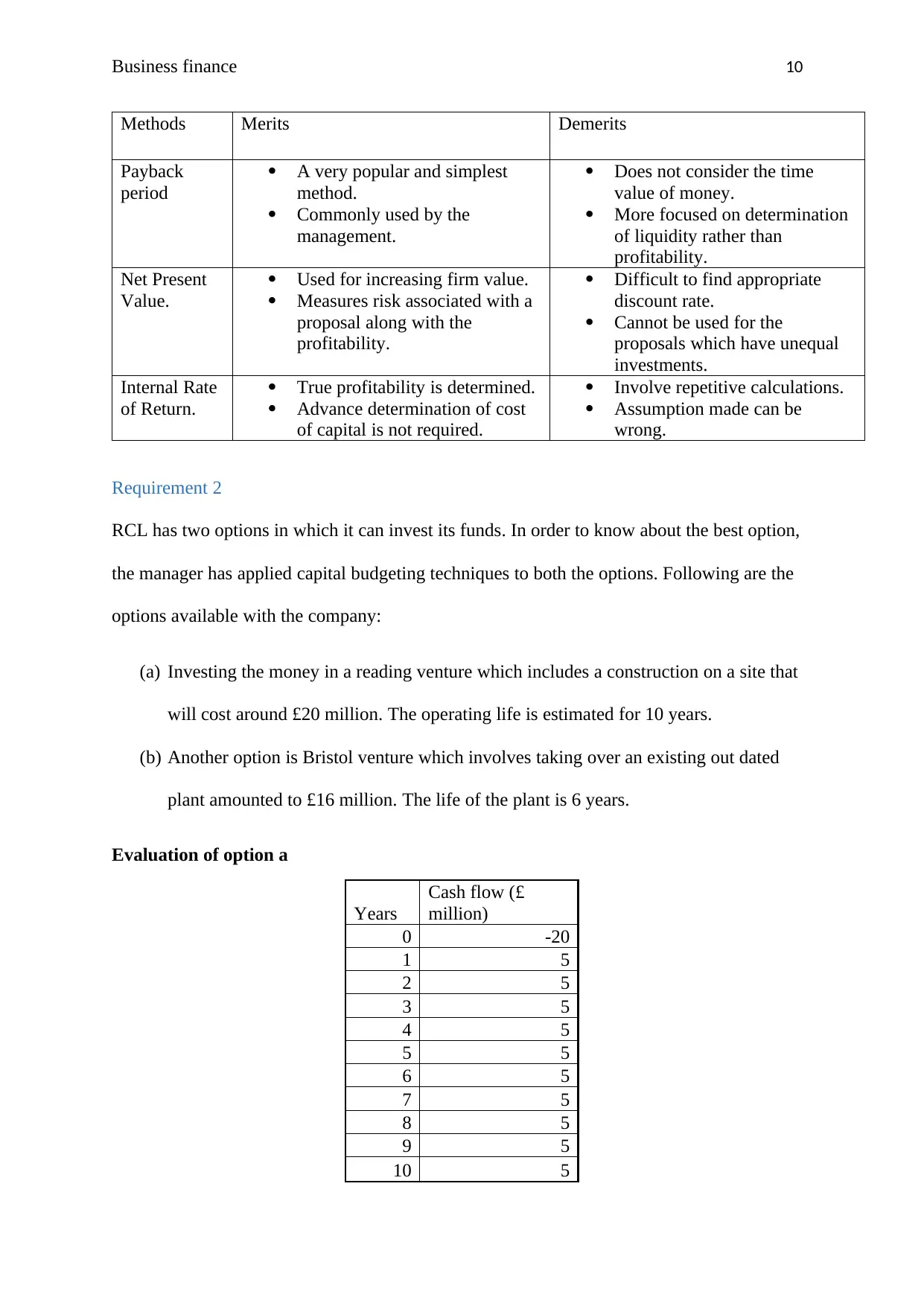
Business finance 10
Methods Merits Demerits
Payback
period
A very popular and simplest
method.
Commonly used by the
management.
Does not consider the time
value of money.
More focused on determination
of liquidity rather than
profitability.
Net Present
Value.
Used for increasing firm value.
Measures risk associated with a
proposal along with the
profitability.
Difficult to find appropriate
discount rate.
Cannot be used for the
proposals which have unequal
investments.
Internal Rate
of Return.
True profitability is determined.
Advance determination of cost
of capital is not required.
Involve repetitive calculations.
Assumption made can be
wrong.
Requirement 2
RCL has two options in which it can invest its funds. In order to know about the best option,
the manager has applied capital budgeting techniques to both the options. Following are the
options available with the company:
(a) Investing the money in a reading venture which includes a construction on a site that
will cost around £20 million. The operating life is estimated for 10 years.
(b) Another option is Bristol venture which involves taking over an existing out dated
plant amounted to £16 million. The life of the plant is 6 years.
Evaluation of option a
Years
Cash flow (£
million)
0 -20
1 5
2 5
3 5
4 5
5 5
6 5
7 5
8 5
9 5
10 5
Methods Merits Demerits
Payback
period
A very popular and simplest
method.
Commonly used by the
management.
Does not consider the time
value of money.
More focused on determination
of liquidity rather than
profitability.
Net Present
Value.
Used for increasing firm value.
Measures risk associated with a
proposal along with the
profitability.
Difficult to find appropriate
discount rate.
Cannot be used for the
proposals which have unequal
investments.
Internal Rate
of Return.
True profitability is determined.
Advance determination of cost
of capital is not required.
Involve repetitive calculations.
Assumption made can be
wrong.
Requirement 2
RCL has two options in which it can invest its funds. In order to know about the best option,
the manager has applied capital budgeting techniques to both the options. Following are the
options available with the company:
(a) Investing the money in a reading venture which includes a construction on a site that
will cost around £20 million. The operating life is estimated for 10 years.
(b) Another option is Bristol venture which involves taking over an existing out dated
plant amounted to £16 million. The life of the plant is 6 years.
Evaluation of option a
Years
Cash flow (£
million)
0 -20
1 5
2 5
3 5
4 5
5 5
6 5
7 5
8 5
9 5
10 5
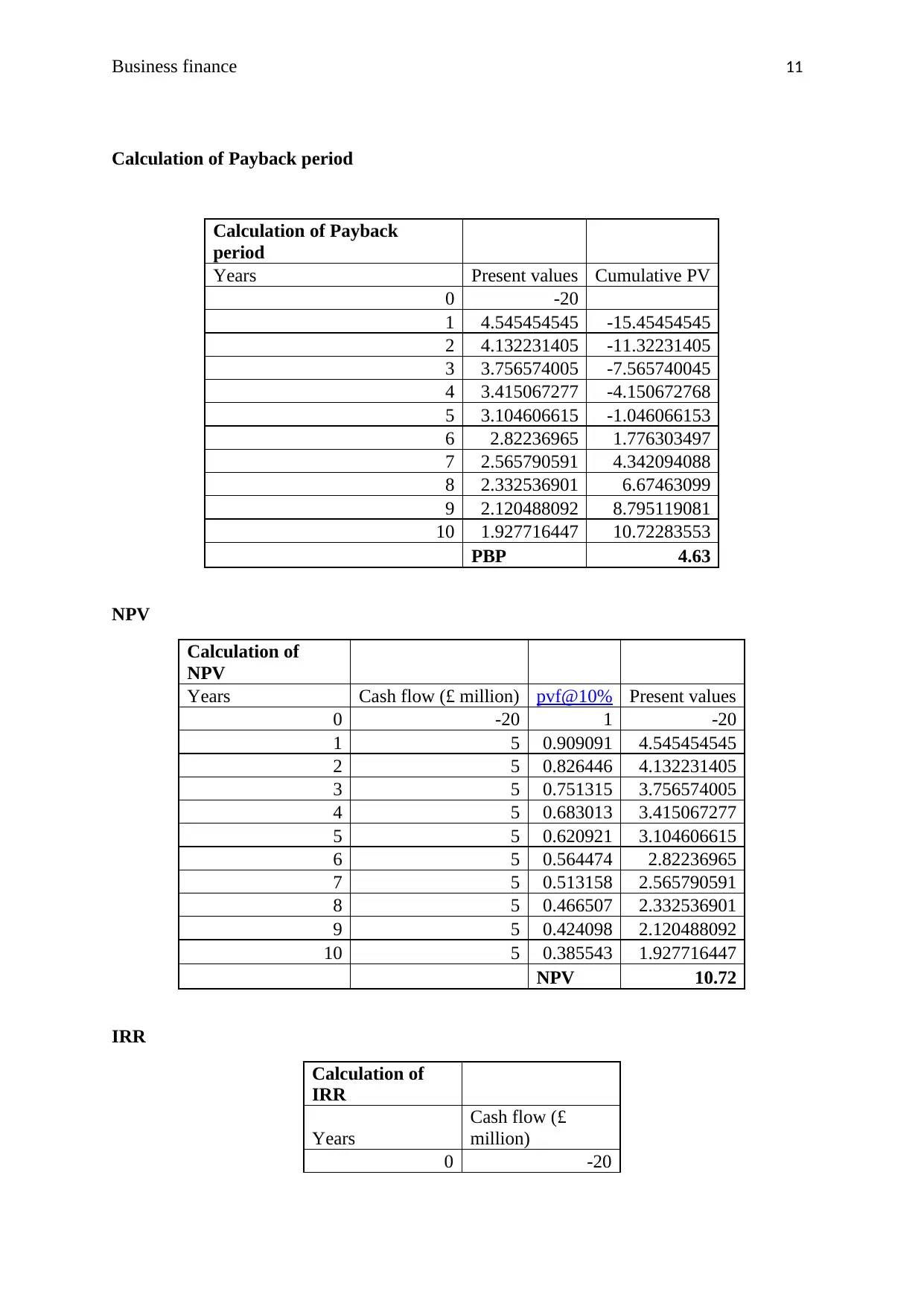
Business finance 11
Calculation of Payback period
Calculation of Payback
period
Years Present values Cumulative PV
0 -20
1 4.545454545 -15.45454545
2 4.132231405 -11.32231405
3 3.756574005 -7.565740045
4 3.415067277 -4.150672768
5 3.104606615 -1.046066153
6 2.82236965 1.776303497
7 2.565790591 4.342094088
8 2.332536901 6.67463099
9 2.120488092 8.795119081
10 1.927716447 10.72283553
PBP 4.63
NPV
Calculation of
NPV
Years Cash flow (£ million) pvf@10% Present values
0 -20 1 -20
1 5 0.909091 4.545454545
2 5 0.826446 4.132231405
3 5 0.751315 3.756574005
4 5 0.683013 3.415067277
5 5 0.620921 3.104606615
6 5 0.564474 2.82236965
7 5 0.513158 2.565790591
8 5 0.466507 2.332536901
9 5 0.424098 2.120488092
10 5 0.385543 1.927716447
NPV 10.72
IRR
Calculation of
IRR
Years
Cash flow (£
million)
0 -20
Calculation of Payback period
Calculation of Payback
period
Years Present values Cumulative PV
0 -20
1 4.545454545 -15.45454545
2 4.132231405 -11.32231405
3 3.756574005 -7.565740045
4 3.415067277 -4.150672768
5 3.104606615 -1.046066153
6 2.82236965 1.776303497
7 2.565790591 4.342094088
8 2.332536901 6.67463099
9 2.120488092 8.795119081
10 1.927716447 10.72283553
PBP 4.63
NPV
Calculation of
NPV
Years Cash flow (£ million) pvf@10% Present values
0 -20 1 -20
1 5 0.909091 4.545454545
2 5 0.826446 4.132231405
3 5 0.751315 3.756574005
4 5 0.683013 3.415067277
5 5 0.620921 3.104606615
6 5 0.564474 2.82236965
7 5 0.513158 2.565790591
8 5 0.466507 2.332536901
9 5 0.424098 2.120488092
10 5 0.385543 1.927716447
NPV 10.72
IRR
Calculation of
IRR
Years
Cash flow (£
million)
0 -20
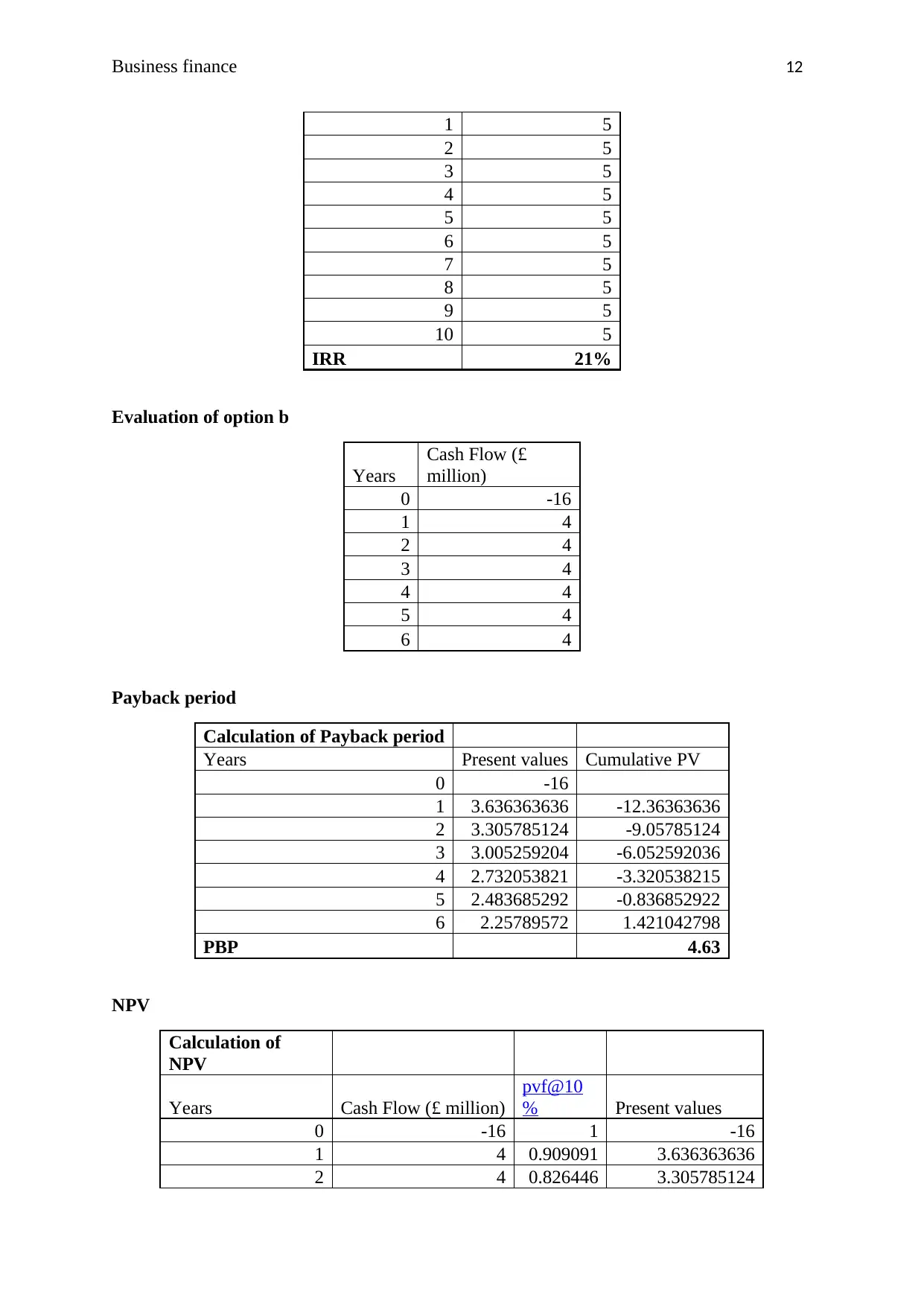
Business finance 12
1 5
2 5
3 5
4 5
5 5
6 5
7 5
8 5
9 5
10 5
IRR 21%
Evaluation of option b
Years
Cash Flow (£
million)
0 -16
1 4
2 4
3 4
4 4
5 4
6 4
Payback period
Calculation of Payback period
Years Present values Cumulative PV
0 -16
1 3.636363636 -12.36363636
2 3.305785124 -9.05785124
3 3.005259204 -6.052592036
4 2.732053821 -3.320538215
5 2.483685292 -0.836852922
6 2.25789572 1.421042798
PBP 4.63
NPV
Calculation of
NPV
Years Cash Flow (£ million)
pvf@10
% Present values
0 -16 1 -16
1 4 0.909091 3.636363636
2 4 0.826446 3.305785124
1 5
2 5
3 5
4 5
5 5
6 5
7 5
8 5
9 5
10 5
IRR 21%
Evaluation of option b
Years
Cash Flow (£
million)
0 -16
1 4
2 4
3 4
4 4
5 4
6 4
Payback period
Calculation of Payback period
Years Present values Cumulative PV
0 -16
1 3.636363636 -12.36363636
2 3.305785124 -9.05785124
3 3.005259204 -6.052592036
4 2.732053821 -3.320538215
5 2.483685292 -0.836852922
6 2.25789572 1.421042798
PBP 4.63
NPV
Calculation of
NPV
Years Cash Flow (£ million)
pvf@10
% Present values
0 -16 1 -16
1 4 0.909091 3.636363636
2 4 0.826446 3.305785124
Paraphrase This Document
Need a fresh take? Get an instant paraphrase of this document with our AI Paraphraser
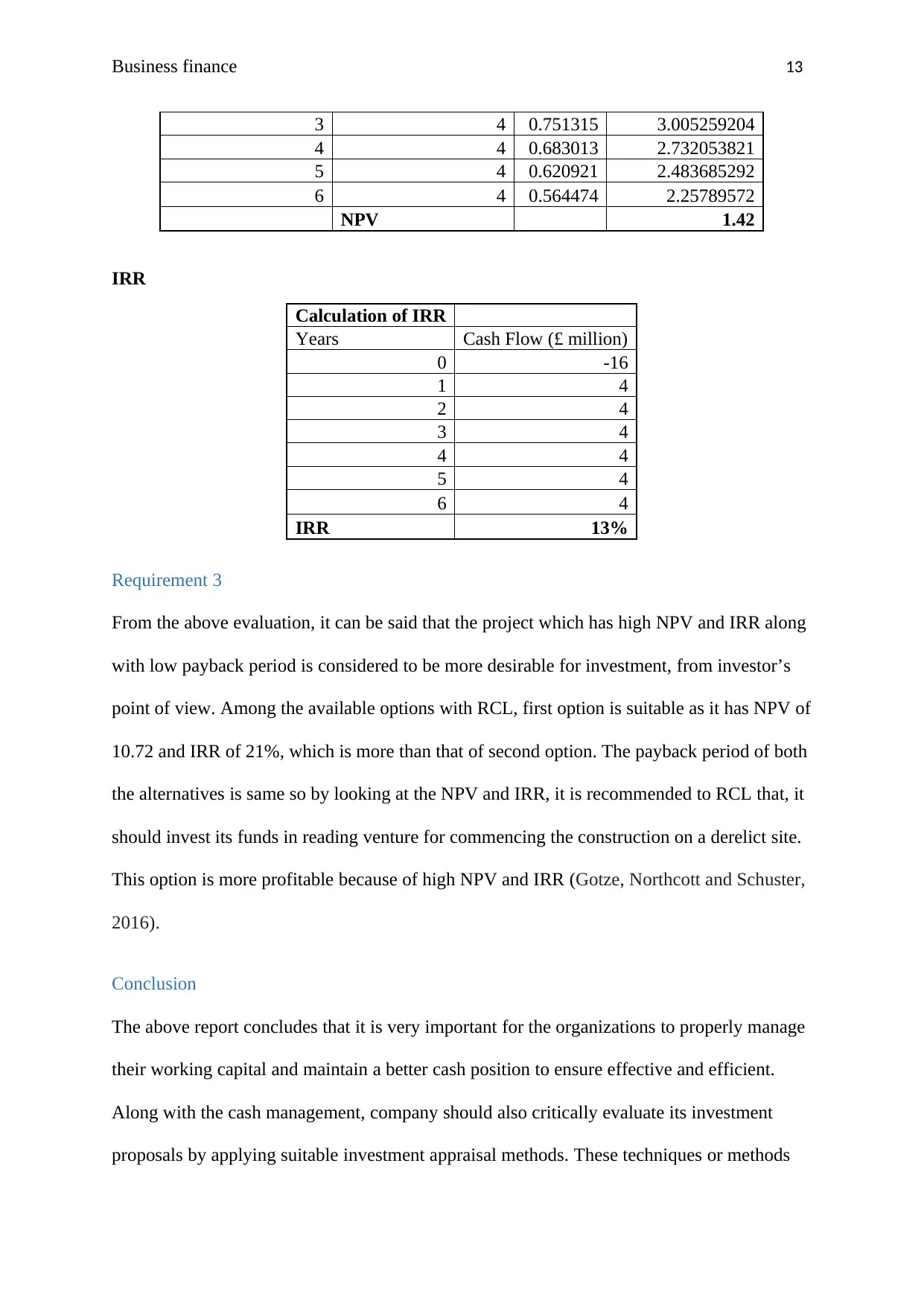
Business finance 13
3 4 0.751315 3.005259204
4 4 0.683013 2.732053821
5 4 0.620921 2.483685292
6 4 0.564474 2.25789572
NPV 1.42
IRR
Calculation of IRR
Years Cash Flow (£ million)
0 -16
1 4
2 4
3 4
4 4
5 4
6 4
IRR 13%
Requirement 3
From the above evaluation, it can be said that the project which has high NPV and IRR along
with low payback period is considered to be more desirable for investment, from investor’s
point of view. Among the available options with RCL, first option is suitable as it has NPV of
10.72 and IRR of 21%, which is more than that of second option. The payback period of both
the alternatives is same so by looking at the NPV and IRR, it is recommended to RCL that, it
should invest its funds in reading venture for commencing the construction on a derelict site.
This option is more profitable because of high NPV and IRR (Gotze, Northcott and Schuster,
2016).
Conclusion
The above report concludes that it is very important for the organizations to properly manage
their working capital and maintain a better cash position to ensure effective and efficient.
Along with the cash management, company should also critically evaluate its investment
proposals by applying suitable investment appraisal methods. These techniques or methods
3 4 0.751315 3.005259204
4 4 0.683013 2.732053821
5 4 0.620921 2.483685292
6 4 0.564474 2.25789572
NPV 1.42
IRR
Calculation of IRR
Years Cash Flow (£ million)
0 -16
1 4
2 4
3 4
4 4
5 4
6 4
IRR 13%
Requirement 3
From the above evaluation, it can be said that the project which has high NPV and IRR along
with low payback period is considered to be more desirable for investment, from investor’s
point of view. Among the available options with RCL, first option is suitable as it has NPV of
10.72 and IRR of 21%, which is more than that of second option. The payback period of both
the alternatives is same so by looking at the NPV and IRR, it is recommended to RCL that, it
should invest its funds in reading venture for commencing the construction on a derelict site.
This option is more profitable because of high NPV and IRR (Gotze, Northcott and Schuster,
2016).
Conclusion
The above report concludes that it is very important for the organizations to properly manage
their working capital and maintain a better cash position to ensure effective and efficient.
Along with the cash management, company should also critically evaluate its investment
proposals by applying suitable investment appraisal methods. These techniques or methods
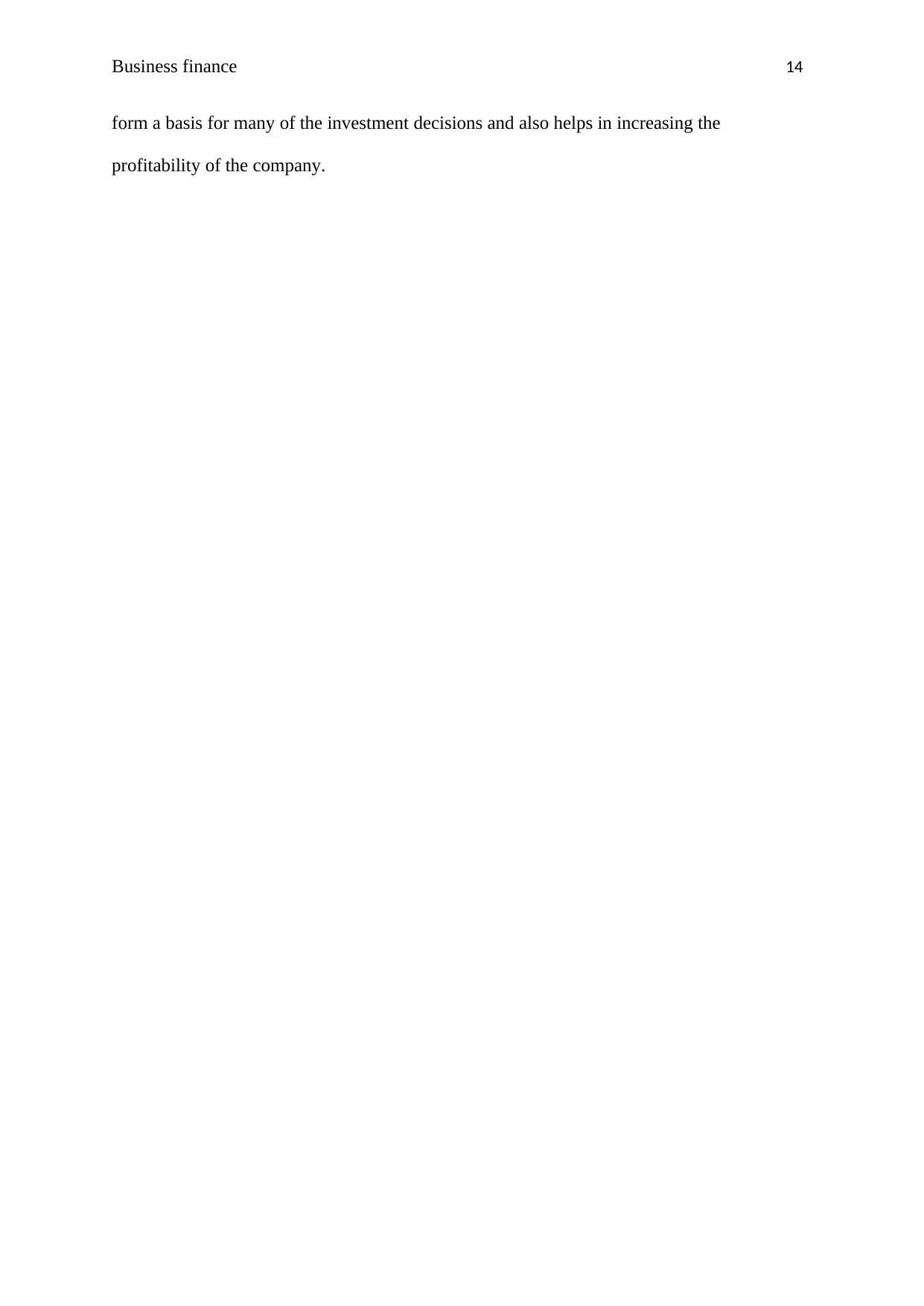
Business finance 14
form a basis for many of the investment decisions and also helps in increasing the
profitability of the company.
form a basis for many of the investment decisions and also helps in increasing the
profitability of the company.
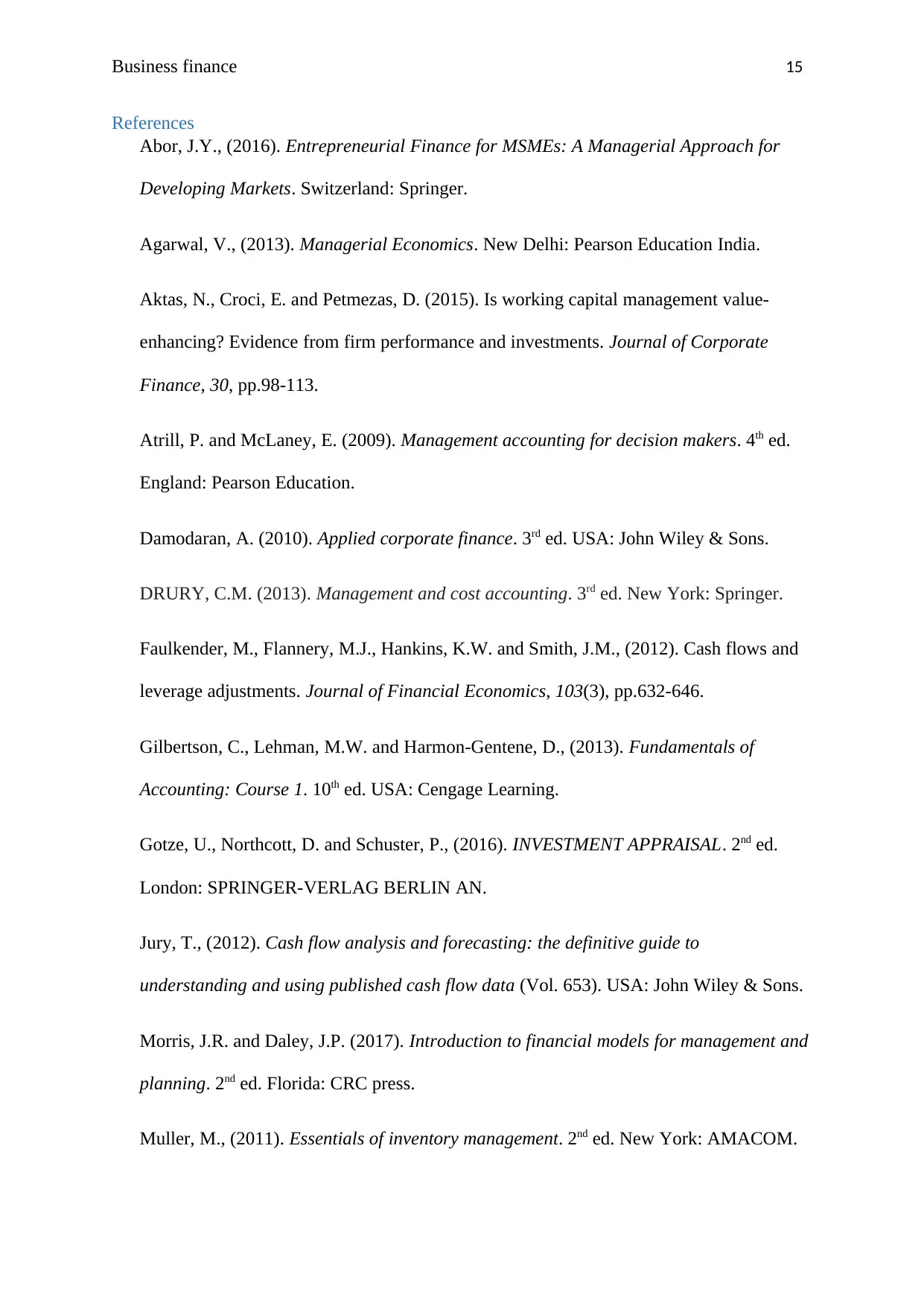
Business finance 15
References
Abor, J.Y., (2016). Entrepreneurial Finance for MSMEs: A Managerial Approach for
Developing Markets. Switzerland: Springer.
Agarwal, V., (2013). Managerial Economics. New Delhi: Pearson Education India.
Aktas, N., Croci, E. and Petmezas, D. (2015). Is working capital management value-
enhancing? Evidence from firm performance and investments. Journal of Corporate
Finance, 30, pp.98-113.
Atrill, P. and McLaney, E. (2009). Management accounting for decision makers. 4th ed.
England: Pearson Education.
Damodaran, A. (2010). Applied corporate finance. 3rd ed. USA: John Wiley & Sons.
DRURY, C.M. (2013). Management and cost accounting. 3rd ed. New York: Springer.
Faulkender, M., Flannery, M.J., Hankins, K.W. and Smith, J.M., (2012). Cash flows and
leverage adjustments. Journal of Financial Economics, 103(3), pp.632-646.
Gilbertson, C., Lehman, M.W. and Harmon-Gentene, D., (2013). Fundamentals of
Accounting: Course 1. 10th ed. USA: Cengage Learning.
Gotze, U., Northcott, D. and Schuster, P., (2016). INVESTMENT APPRAISAL. 2nd ed.
London: SPRINGER-VERLAG BERLIN AN.
Jury, T., (2012). Cash flow analysis and forecasting: the definitive guide to
understanding and using published cash flow data (Vol. 653). USA: John Wiley & Sons.
Morris, J.R. and Daley, J.P. (2017). Introduction to financial models for management and
planning. 2nd ed. Florida: CRC press.
Muller, M., (2011). Essentials of inventory management. 2nd ed. New York: AMACOM.
References
Abor, J.Y., (2016). Entrepreneurial Finance for MSMEs: A Managerial Approach for
Developing Markets. Switzerland: Springer.
Agarwal, V., (2013). Managerial Economics. New Delhi: Pearson Education India.
Aktas, N., Croci, E. and Petmezas, D. (2015). Is working capital management value-
enhancing? Evidence from firm performance and investments. Journal of Corporate
Finance, 30, pp.98-113.
Atrill, P. and McLaney, E. (2009). Management accounting for decision makers. 4th ed.
England: Pearson Education.
Damodaran, A. (2010). Applied corporate finance. 3rd ed. USA: John Wiley & Sons.
DRURY, C.M. (2013). Management and cost accounting. 3rd ed. New York: Springer.
Faulkender, M., Flannery, M.J., Hankins, K.W. and Smith, J.M., (2012). Cash flows and
leverage adjustments. Journal of Financial Economics, 103(3), pp.632-646.
Gilbertson, C., Lehman, M.W. and Harmon-Gentene, D., (2013). Fundamentals of
Accounting: Course 1. 10th ed. USA: Cengage Learning.
Gotze, U., Northcott, D. and Schuster, P., (2016). INVESTMENT APPRAISAL. 2nd ed.
London: SPRINGER-VERLAG BERLIN AN.
Jury, T., (2012). Cash flow analysis and forecasting: the definitive guide to
understanding and using published cash flow data (Vol. 653). USA: John Wiley & Sons.
Morris, J.R. and Daley, J.P. (2017). Introduction to financial models for management and
planning. 2nd ed. Florida: CRC press.
Muller, M., (2011). Essentials of inventory management. 2nd ed. New York: AMACOM.
Secure Best Marks with AI Grader
Need help grading? Try our AI Grader for instant feedback on your assignments.
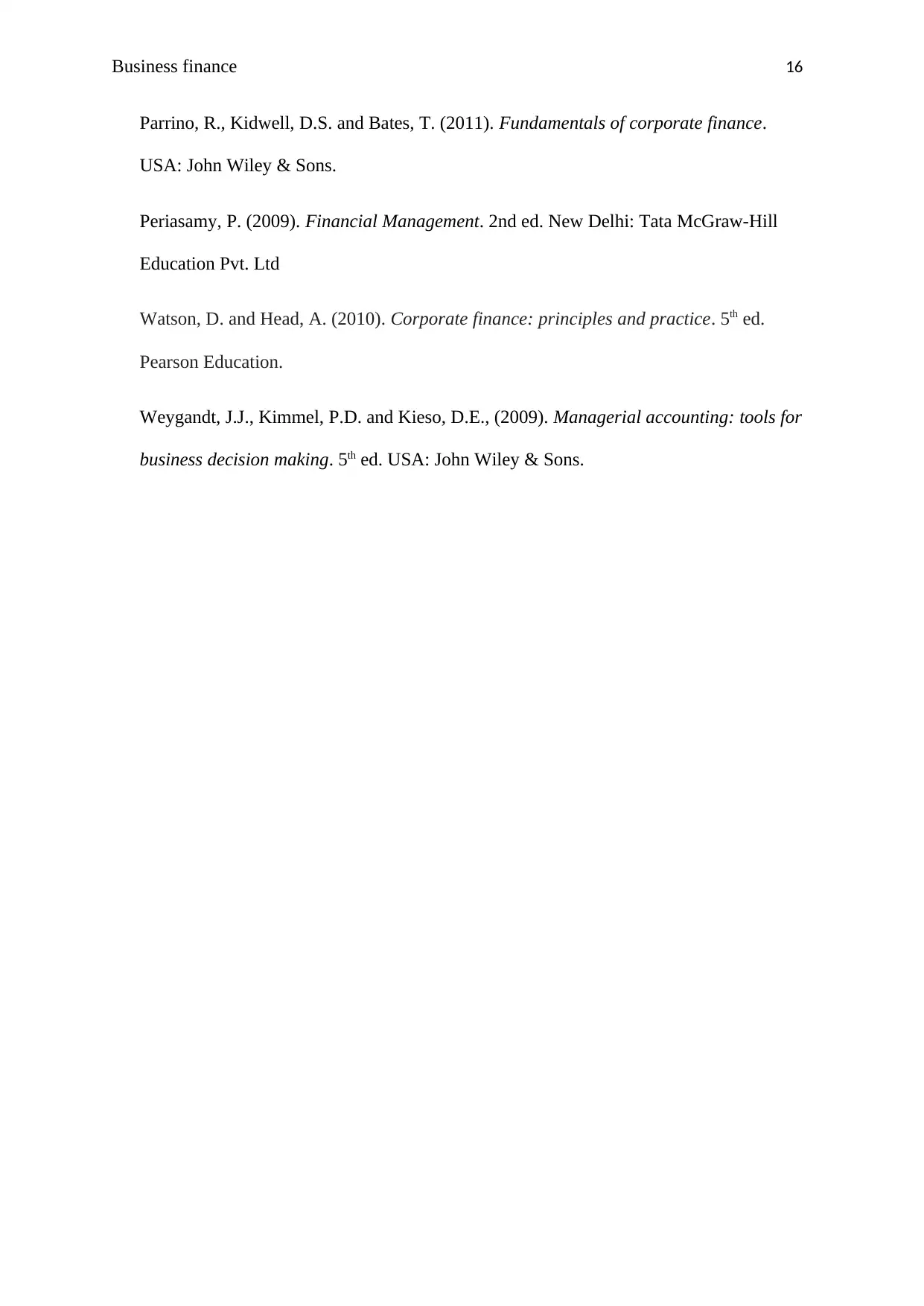
Business finance 16
Parrino, R., Kidwell, D.S. and Bates, T. (2011). Fundamentals of corporate finance.
USA: John Wiley & Sons.
Periasamy, P. (2009). Financial Management. 2nd ed. New Delhi: Tata McGraw-Hill
Education Pvt. Ltd
Watson, D. and Head, A. (2010). Corporate finance: principles and practice. 5th ed.
Pearson Education.
Weygandt, J.J., Kimmel, P.D. and Kieso, D.E., (2009). Managerial accounting: tools for
business decision making. 5th ed. USA: John Wiley & Sons.
Parrino, R., Kidwell, D.S. and Bates, T. (2011). Fundamentals of corporate finance.
USA: John Wiley & Sons.
Periasamy, P. (2009). Financial Management. 2nd ed. New Delhi: Tata McGraw-Hill
Education Pvt. Ltd
Watson, D. and Head, A. (2010). Corporate finance: principles and practice. 5th ed.
Pearson Education.
Weygandt, J.J., Kimmel, P.D. and Kieso, D.E., (2009). Managerial accounting: tools for
business decision making. 5th ed. USA: John Wiley & Sons.
1 out of 17
Related Documents
Your All-in-One AI-Powered Toolkit for Academic Success.
+13062052269
info@desklib.com
Available 24*7 on WhatsApp / Email
![[object Object]](/_next/static/media/star-bottom.7253800d.svg)
Unlock your academic potential
© 2024 | Zucol Services PVT LTD | All rights reserved.




